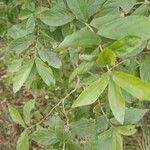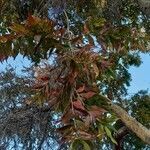Tree or shrub, 1-12 m high, spreading, densely foliaged. Leaves elliptic or oblong-elliptic, light to medium green, very seldom dark green; lamina often slightly twisted, margins occasionally, slightly wavy, lower surface distinctly hairy, at least on midrib and secondary veins, rarely glabrous; lower intersecondary veins raised. Inflorescence a subcapitulate spike, 15-20 mm long. Flowers with lower receptacle densely pubescent; upper receptacle ± campanulate; pedicels absent. Flowering time Aug.-Nov. Fruit 4-winged, yellowish green, rarely tinged pink.
Figures by Engler and Diels (loc. cit.) show a markedly 2-seriate insertion of the stamens but in all the flowers I have dissected they appear to be very nearly 1-seriate and close to the margin of the disk. The petals are very variable in shape though fairly constant in the flowers of an individual. This kind of variation commonly occurs in species of Combretum and often appears to be without taxonomic significance though in some other cases the shape of the petal may be quite a useful character.
Leaves subopposite or occasionally 3-verticillate; lamina sometimes pale-yellow when young, usually c. 5 x 2 cm., elliptic, rather inconspicuously lepidote on both surfaces otherwise nearly glabrous above except for variable hairiness on the midrib and nerves, tomentose to nearly glabrous beneath, apex usually acute and mucronate, base cuneate; lateral nerves 6–8(12) pairs; petiole 1–4 mm. long, tomentose.
Lower receptacle 1·5–2·5 x 1 mm., usually tomentose rarely pubescent; upper receptacle 2–2·5 x 3 mm., broadly campanulate, pubescent to densely pubescent, with some scales visible when the indumentum is not too dense.
Inflorescences usually of unbranched axillary spikes up to 2(3) cm. long, rarely forming short panicles by the suppression of leaves on short shoots; rhachis and peduncles usually tomentose more rarely glabrescent.
Fruit 1·3 x 1 cm., subcircular to broadly elliptic in outline, lepidote and pubescent, apical peg absent, wings c. 5 mm. wide, slightly decurrent at the base, stipe up to 7 mm. long.
Tree, 10(-19) m high. Leaves pubescent to tomentose beneath, at least on midrib and secondary veins. Fruit 15 mm long. Flowers pubescent to tomentose, cream or yellow.
Petals c. 1·5 x 1 mm., obovate, narrowly obovate, spathulate or narrowly elliptic, sometimes emarginate, unguiculate, glabrous.
Small to large spreading tree; young branchlets tomentose with rather persistent indumentum, pinkish after shedding the bark.
Scales as for the section, almost always some with at least 12 primary walls.
Disk 1·5 x l, cupuliform, glabrous, with a pilose margin free for c. 0·5 mm.
Sepals c. 1 x 1·3–1·5 mm., debate to broadly debate.
Stamen-filaments 5 mm. long; anthers 1 mm. long.
Flowers cream or yellow, usually ± congested.



